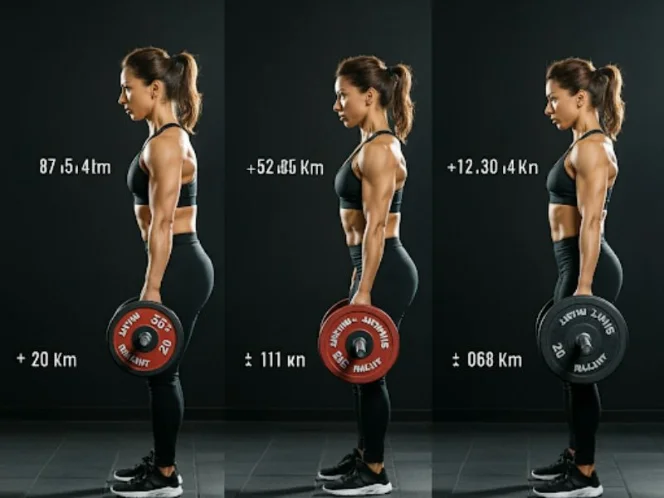Are you tired of the myth that weightlifting is just for men? It’s time to rewrite the narrative! In this blog post, we’ll debunk the common misconceptions about women and weightlifting and highlight the incredible benefits this form of exercise offers.
Ever heard the phrase “bulky broad”? This outdated stereotype has discouraged many women from stepping into the weight room, fearing they’ll transform into muscle-bound monsters. But the truth is, building significant muscle mass is extremely difficult for women due to hormonal differences.
So, what can you expect from weightlifting?
- Increased strength and power: Lift heavier weights, feel more confident, and perform everyday tasks with ease.
- Improved bone density: Reduce your risk of osteoporosis and maintain strong bones throughout your life.
- Enhanced metabolism and fat loss: Burn more calories at rest and achieve a toned, healthy physique.
- Better mood and mental health: Feel empowered, boost your self-esteem, and reduce stress and anxiety.
Ready to ditch the dumbbells and embrace the barbell? We’ll guide you through the process, from overcoming common myths to getting started with safe and effective weightlifting routines. Let’s unlock your inner strength and empower you to achieve your fitness goals!
Debunking the Myths: Why You Shouldn’t Be Afraid to Lift Weights
Many women are hesitant to start weightlifting due to common myths and misconceptions. These myths often center around the fear of becoming bulky, the belief that weightlifting is only for men, and concerns about safety. However, these myths are simply not true. In reality, weightlifting offers a wide range of benefits for women of all ages and fitness levels.
Myth 1: “I’ll get bulky.”

One of the most common myths about weightlifting is that it will make women bulky. This is simply not true. Women naturally have much lower levels of testosterone than men, which is the hormone primarily responsible for muscle growth. This means that it is very difficult for women to build significant muscle mass, even with intense weightlifting training.
In fact, weightlifting can actually help women achieve a toned and sculpted physique. By building muscle, women can increase their metabolism, burn more calories at rest, and improve their body composition. This can lead to a leaner and more defined appearance, without the bulkiness that many women fear.
Myth 2: “Weightlifting is only for men.”

Another common myth is that weightlifting is only for men. This is simply not the case. Weightlifting is a great exercise for people of all genders and fitness levels. In fact, there are many benefits that women can specifically reap from weightlifting, such as improved bone density, reduced risk of osteoporosis, and increased strength and power.
Weightlifting can also be a great way for women to boost their confidence and self-esteem. Seeing their bodies become stronger and more capable can be a very empowering experience.
Myth 3: “Weightlifting is dangerous.”

Weightlifting can be a safe and effective exercise when done properly. However, it is important to learn proper form and technique to avoid injury. It is also important to listen to your body and take rest days when needed.
If you are new to weightlifting, it is a good idea to start with a light weight and gradually increase the weight as you get stronger. You can also hire a personal trainer to help you learn proper form and technique.
With proper precautions, weightlifting is a safe and effective exercise for women of all ages and fitness levels.
In addition to debunking these common myths, it is also important to highlight the many benefits that weightlifting offers for women.

- Increased strength and power: Weightlifting can help women become stronger and more powerful, which can improve their performance in everyday activities and sports.
- Improved bone density: Weightlifting can help to increase bone density, which can help to reduce the risk of osteoporosis.
- Enhanced metabolism and fat loss: Weightlifting can help to boost metabolism and burn more calories at rest, which can lead to weight loss and a leaner physique.
- Better mood and mental health: Weightlifting can help to improve mood and reduce stress and anxiety.
- Increased confidence and self-esteem: Weightlifting can help women feel more confident and empowered in their bodies.
Weightlifting is a great way for women to improve their overall health and fitness. Don’t let the myths hold you back from experiencing the many benefits that weightlifting has to offer.
Addressing Your Weightlifting Concerns
It’s natural to have questions about weightlifting, especially if you’re new to it or have been hesitant due to prevailing myths. Let’s tackle some common queries to empower you with the knowledge and confidence to embrace the weights.
What kind of weightlifting should women do?

The beauty of weightlifting is its versatility! There’s no single “right” way to lift weights, and women can benefit from various approaches. Here are a few popular options:
- Compound exercises: These movements engage multiple muscle groups simultaneously, maximizing calorie burn and overall strength gains. Examples include squats, deadlifts, lunges, overhead presses, and rows.
- Bodyweight training: Using your own body weight as resistance is a great way to build functional strength and can be done anywhere, anytime. Think push-ups, pull-ups, planks, and squats.
- Isolation exercises: These target specific muscle groups and can be useful for building strength in certain areas or addressing muscle imbalances. Examples include bicep curls, tricep extensions, and calf raises.
The best approach for you will depend on your goals, preferences, and experience level. Consider incorporating a mix of compound exercises, bodyweight training, and isolation exercises for a well-rounded weightlifting routine.
How much weight should women lift?

The amount of weight you should lift depends on your current strength level and the specific exercise you’re performing. The key is to start with a weight that allows you to maintain proper form and technique throughout the entire set.
If you’re new to weightlifting, start with lighter weights and gradually increase as you get stronger. A good rule of thumb is to choose a weight that allows you to perform 8-12 repetitions with good form. If you can easily do more than 12 reps, it’s time to increase the weight.
Remember, it’s not about lifting the heaviest weight possible; it’s about challenging yourself while maintaining proper form and avoiding injury.
How often should women lift weights?

The ideal frequency for weightlifting depends on your individual goals, fitness level, and recovery capacity. Generally, aiming for 2-3 weightlifting sessions per week is a good starting point.
Allow for at least one day of rest between weightlifting sessions to give your muscles time to recover and rebuild. You can engage in other activities, such as light cardio or yoga, on your rest days.
As you progress, you can gradually increase the frequency or volume of your weightlifting workouts. However, always listen to your body and prioritize rest and recovery to avoid overtraining and injury.
Do I need a gym to lift weights?

Not necessarily! While gyms offer a wide range of equipment and resources, you can effectively lift weights at home with minimal equipment.
Dumbbells, kettlebells, and resistance bands are versatile and affordable options for home weightlifting workouts. You can also utilize your own body weight for resistance training.
Numerous online resources and videos provide guidance on creating effective home weightlifting routines. If you’re unsure where to start, consider consulting with a certified personal trainer who can design a personalized program tailored to your goals and available equipment.
By addressing these common questions, we hope to empower you with the knowledge and confidence to embrace weightlifting and experience its transformative benefits. Remember, it’s never too late to start your weightlifting journey, regardless of your age or fitness level.
Getting Started with Weightlifting: Your Guide to Building Strength and Confidence
Taking the first step towards weightlifting can be intimidating, but with the right guidance and support, you can embark on a transformative journey towards strength, fitness, and confidence. Here are some key steps to get you started:
1. Find a qualified trainer:

A certified personal trainer can provide invaluable guidance and support, especially if you’re new to weightlifting. They can help you design a safe and effective workout program, teach you proper form and technique, and motivate you to reach your goals.
Look for a trainer who is certified by a reputable organization, such as the National Strength and Conditioning Association (NSCA) or the American Council on Exercise (ACE). They should also have experience working with women and understand your specific needs and goals.
2. Start with compound exercises:

Compound exercises engage multiple muscle groups at the same time, making them an efficient way to build strength and burn calories. Some examples of compound exercises include squats, deadlifts, lunges, push-ups, pull-ups, and rows.
Start with lighter weights and gradually increase the weight as you get stronger. It’s important to focus on proper form throughout the entire exercise to avoid injury.
3. Focus on proper form:

Proper form is essential for maximizing the benefits of weightlifting and preventing injuries. It’s important to learn the correct technique for each exercise and to pay attention to your body alignment and posture.
If you’re unsure about your form, ask a certified personal trainer for help. You can also watch instructional videos online or in fitness magazines.
4. Gradually increase weight and intensity:

As you get stronger, you can gradually increase the weight you lift and the intensity of your workouts. This will help you continue to challenge your muscles and make progress.
However, it’s important to avoid increasing weight too quickly, as this can lead to injury. Listen to your body and take rest days when needed.
5. Celebrate your progress:

Weightlifting is a journey, not a destination. It’s important to celebrate your progress, no matter how small it may seem. This will help you stay motivated and on track to reach your goals.
Track your progress by keeping a workout journal or taking pictures of yourself. You can also share your progress with friends and family for support and encouragement.
By following these steps, you can get started with weightlifting and experience the many benefits it has to offer. Remember, it’s never too late to start your fitness journey and embrace the power within you!
Embrace Your Strength: Why Weightlifting is for Every Woman

We’ve shattered the myths, explored the benefits, and addressed your concerns. Now, it’s time to embrace the transformative power of weightlifting and unlock your full potential.
Remember, weightlifting isn’t about becoming “bulky” – it’s about building strength, confidence, and a healthier body and mind. It’s about defying outdated stereotypes and embracing a form of exercise that empowers you to feel your best.
From increased bone density and metabolism to improved mood and self-esteem, the benefits of weightlifting are undeniable. Whether you’re a seasoned athlete or just starting your fitness journey, incorporating weights into your routine can revolutionize your approach to health and wellness.
Take Action: Your Journey to a Stronger You Starts Now!

Don’t let fear or misconceptions hold you back any longer. Find a qualified trainer, start with compound exercises, focus on proper form, and gradually increase the challenge. Most importantly, celebrate your progress and enjoy the journey to a stronger, healthier you.
Remember, every rep, every set, and every workout is a step towards a more empowered and confident you. Embrace the challenge, feel the burn, and discover the incredible strength that lies within.




